Construction of Sensory Wheel for Grape Marc Spirits by Integration of UFP, CATA, and RATA Methods
Abstract
1. Introduction
2. Materials and Methods
2.1. Samples
2.2. Sample Preparation
2.3. Assessors
2.4. Experimental Design
2.5. Statistical Analysis
3. Results
3.1. Ultra Flash Profile
| Attributes | % | p-Values | Attributes | % | p-Values |
|---|---|---|---|---|---|
| sweet | 45% | 0.405 | bread | 12% | 0.821 |
| burning | 41% | 0.066 | nuts | 12% | 0.162 |
| coating | 30% | 0.157 | spicy | 12% | 0.880 |
| floral | 28% | 0.086 | medical | 12% | 0.340 |
| bitter | 25% | 0.050 | salty | 12% | 0.680 |
| citrus fruit | 24% | 0.062 | dill | 11% | 0.033 |
| fruity | 22% | 0.036 | earthy | 11% | 0.277 |
| eucalyptus | 20% | 0.030 | smoky | 11% | 0.255 |
| fresh | 19% | 0.568 | grape | 10% | 0.079 |
| grassy | 19% | 0.790 | rose | 10% | 0.022 |
| anise | 19% | 0.257 | mint | 10% | 0.925 |
| dried (hay, straw, tea) | 18% | 0.512 | pine | 10% | 0.529 |
| white flowers | 18% | 0.200 | waxy | 10% | 0.581 |
| petroleum | 18% | 0.023 | berries | 9% | 0.159 |
| woody | 17% | 0.147 | lavender | 9% | 0.108 |
| stone fruit | 17% | 0.232 | fishy | 9% | 0.005 |
| caramel | 17% | 0.028 | rubbery | 9% | 0.059 |
| ethyl acetate | 17% | 0.910 | dry | 7% | 0.660 |
| vanilla | 16% | 0.509 | sea | 7% | 0.220 |
| fatty | 16% | 0.579 | cherry | 7% | 0.256 |
| tropical fruit | 16% | 0.588 | fruit jam | 7% | 0.686 |
| honey | 15% | 0.693 | pool | 6% | 0.101 |
| rough | 15% | 0.128 | butter | 6% | 0.893 |
| soapy | 14% | 0.173 | dusty | 6% | 0.457 |
| pipfruit (apple/pear) | 14% | 0.233 | soil | 6% | 0.397 |
| canned/cooked | 14% | 0.605 | mushroom | 5% | 0.333 |
| dried fruit (plum, raisin, etc.) | 13% | 0.055 | laurel | 3% | 0.325 |
| orange blossom | 13% | 0.680 | animalic | 3% | 0.325 |
| coffee | 3% | 0.488 | |||
| oily | 2% | 0.661 | |||
| acetic acid | 1% | 0.025 |
3.2. Check-All-That-Apply
3.3. Rate-All-That-Apply
3.4. Flavor Wheel
4. Discussion
5. Conclusions
Supplementary Materials
Author Contributions
Funding
Institutional Review Board Statement
Informed Consent Statement
Data Availability Statement
Conflicts of Interest
References
- Darıcı, M.; Özcan, K.; Beypınar, D.; Cabaroglu, T. Sensory lexicon and major volatiles of rakı using descriptive analysis and GC-FID/MS. Foods 2021, 10, 1494. [Google Scholar] [CrossRef] [PubMed]
- Bovo, B.; Carlot, M.; Lombardi, A.; Lomolino, G.; Lante, A.; Giacomini, A.; Corich, V. Exploring the use of Saccharomyces cerevisiae commercial strain and Saccharomycodes ludwigii natural isolate for grape marc fermentation to improve sensory properties of spirits. Food Microbiol. 2014, 41, 33–41. [Google Scholar] [CrossRef]
- Tsapou, E.A.; Tzortzis, P.M.; Koussissi, E. Application of Polarized Projective Mapping combined with Ultra Flash Profiling to a complex− high fatigue product category: The case of Greek grape marc spirits. Food Qual. Prefer. 2024, 118, 105182. [Google Scholar] [CrossRef]
- Soufleros, E.H. Wine and Distillates; Papageorgiou Pub: Thessaloniki, Greece, 1987. [Google Scholar]
- Rodríguez-Solana, R.; Rodríguez, N.; Dominguez, J.M.; Cortés, S. Characterization by chemical and sensory analysis of commercial grape marc distillate (Orujo) aged in oak wood. J. Inst. Brew. 2012, 118, 205–212. [Google Scholar] [CrossRef]
- Tsapou, E.A.; Dourtoglou, V.; Dourtoglou, T.; Sinanoglou, V.; Koussissi, E. Volatile Profile in Greek Grape Marc Spirits with HS-SPME-GC-MS and Chemometrics: Evaluation of Terroir Impact. ACS Omega 2023, 8, 42803–42814. [Google Scholar] [CrossRef]
- Spencer, M.; Sage, E.; Velez, M.; Guinard, J.X. Using Single Free Sorting and Multivariate Explor-atory Methods to Design a New Coffee Taster’s Flavor Wheel. J. Food Sci. 2016, 81, 12. [Google Scholar] [CrossRef] [PubMed]
- Phetxumphou, K.; Cox, A.N.; Lahne, J. Development and characterization of a check-all-that-apply (CATA) lexicon for Virginia hard (alcoholic) ciders. J. Am. Soc. Brew. Chem. 2020, 78, 299–307. [Google Scholar] [CrossRef]
- Silvello, G.C.; Bortoletto, A.M.; Alcarde, A.R. The barrel aged beer wheel: A tool for sensory assessment. J. Inst. Brew. 2020, 126, 382–393. [Google Scholar] [CrossRef]
- Asih, N.E.; Ramadhanty, K.P.; Ramandias, J.; Azkarama, F.; Sunarharum, W.B. Lexicon, sensory wheel and kit as sensory communication tools: A review. In IOP Conference Series: Earth and Environmental Science; IOP Publishing: Bristol, UK, 2021; Volume 924, p. 012027. [Google Scholar] [CrossRef]
- Meilgaard, M.C.; Dalgliesh, C.E.; Clapperton, J.F. Beer flavor terminology. J. Am. Soc. Brew. Chem. 1979, 37, 47–52. [Google Scholar] [CrossRef]
- Noble, A.C.; Arnold, R.A.; Masuda, B.M.; Pecore, S.D.; Schmidt, J.O.; Stern, P.M. Progress towards a standardized system of wine aroma terminology. Am. J. Enol. Vitic. 1984, 35, 107–109. [Google Scholar] [CrossRef]
- Noble, A.C.; Arnold, R.A.; Buechsenstein, J.; Leach, E.J.; Schmidt, J.O.; Stern, P.M. Modification of a standardized system of wine aroma terminology. Am. J. Enol. Vitic. 1987, 38, 143–146. [Google Scholar] [CrossRef]
- Lee, K.Y.M.; Paterson, A.; Piggott, J.R.; Richardson, G.D. Origins of flavour in whiskies and a revised flavour wheel: A review. J. Inst. Brew. 2001, 107, 287–313. [Google Scholar] [CrossRef]
- Jolly, N.P.; Hattingh, S. A brandy aroma wheel for South African brandy. S. Afr. J. Enol. Vitic. 2001, 22, 16–21. [Google Scholar] [CrossRef]
- Monteiro, B.; Vilela, A.; Correia, E. Sensory profile of pink port wines: Development of a flavour lexicon. Flavour Fragr. J. 2014, 29, 50–58. [Google Scholar] [CrossRef]
- Koch, I.S.; Muller, M.; Joubert, E.; Van der Rijst, M.; Næs, T. Sensory characterization of rooibos tea and the development of a rooibos sensory wheel and lexicon. Food Res. Int. 2012, 46, 217–228. [Google Scholar] [CrossRef]
- Donnell, E.M.; Hulin-Bertaud, S.; Sheehan, E.M.; Delahunty, C.M. Development and learning process of a sensory vocabulary for the odor evaluation of selected distilled beverages using descriptive analysis. J. Sens. Stud. 2001, 16, 425–445. [Google Scholar] [CrossRef]
- Tsachaki, M.; Arnaoutopoulou, A.P.; Margomenou, L.; Roubedakis, S.C.; Zabetakis, I. Develop-ment of a suitable lexicon for sensory studies of the anise-flavoured spirits ouzo and tsipouro. Flavour Fragr. J. 2010, 25, 468–474. [Google Scholar] [CrossRef]
- Ares, G.; Jaeger, S.R. Check-all-that-apply questions: Influence of attribute order on sensory product characterization. Food Qual. Prefer. 2013, 28, 141–153. [Google Scholar] [CrossRef]
- Ares, G.; Bruzzone, F.; Vidal, L.; Cadena, R.S.; Giménez, A.; Pineau, B.; Hunter, D.C.; Paisley, A.G.; Jaeger, S.R. Evalua-tion of a rating-based variant of check-all-that-apply questions: Rate-all-that-apply (RATA). Food Qual. Prefer. 2014, 36, 87–95. [Google Scholar] [CrossRef]
- ISO8589: 2007; Sensory Analysis—General Guidance for the Design of Test Rooms. International Organization of Standardization: Geneva, Switzerland, 2007; 2nd ed.
- De Pelsmaeker, S.; De Clercq, G.; Gellynck, X.; Schouteten, J.J. Development of a Sensory Wheel and Lexi-con for Chocolate. Food Res. Int. 2019, 116, 1183–1191. [Google Scholar] [CrossRef]
- Meyners, M.; Castura, J.C. Randomization of CATA attributes: Should attribute lists be allocated to assessors or to samples? Food Qual. Prefer. 2016, 48, 210–215. [Google Scholar] [CrossRef]
- Lumivero. XLSTAT Statistical and Data Analysis Solution. 2025. Available online: https://www.xlstat.com/ (accessed on 31 July 2024).
- Tura, M.; Mandrioli, M.; Valli, E.; Dinnella, C.; Gallina Toschi, T. Sensory wheel and lexicon for the description of cold-pressed hemp seed oil. Foods 2023, 12, 661. [Google Scholar] [CrossRef]
- Ickes, C.M.; Lee, S.Y.; Cadwallader, K.R. Novel creation of a rum flavor lexicon through the use of web-based material. J. Food Sci. 2017, 82, 1216–1223. [Google Scholar] [CrossRef] [PubMed]
- Yu, M.; Zheng, C.; Xie, Q.; Tang, Y.; Wang, Y.; Wang, B.; Song, H.; Zhou, Y.; Xu, Y.; Yang, R. Flavor wheel construction and sensory profile description of human milk. Nutrients 2022, 14, 5387. [Google Scholar] [CrossRef] [PubMed]
- Larssen, W.E.; Monteleone, E.; Hersleth, M. Sensory description of marine oils through develop-ment of a sensory wheel and vocabulary. Food Res. Int. 2018, 106, 45–53. [Google Scholar] [CrossRef]
- Bordeu, E.; Formas, G.; Agosin, E. Proposal for a standardized set of sensory terms for pisco, a young muscat wine distillate. Am. J. Enol. Vitic. 2004, 55, 104–107. [Google Scholar] [CrossRef]
- ISO 11035:1994; Sensory Analysis—Identification and Selection of Descriptors for Establishing a Sensory Profile by a Multidimensional Approach. International Organization of Standardization: Geneva, Switzerland, 1994; 1st ed.
- .Bruzzone, F.; Vidal, L.; Antúnez, L.; Giménez, A.; Deliza, R.; Ares, G. Comparison of intensity scales and CATA questions in new product development: Sensory characterisation and directions for product reformulation of milk desserts. Food Qual. Prefer. 2015, 44, 183–193. [Google Scholar] [CrossRef]
- Vidal, L.; Tárrega, A.; Antúnez, L.; Ares, G.; Jaeger, S.R. Comparison of correspondence analysis based on Hellinger and chi-square distances to obtain sensory spaces from check-all-that-apply (CATA) questions. Food Qual. Prefer. 2015, 43, 106–112. [Google Scholar] [CrossRef]
- Krosnick, J.A.; Alwin, D.F. An evaluation of a cognitive theory of response-order effects in survey measurement. Public Opin. Q. 1987, 51, 201–219. [Google Scholar] [CrossRef]
- Rasinski, K.A.; Mingay, D.; Bradburn, N.M. Do respondents really “mark all that apply” on self-administered questions? Public Opin. Q. 1994, 58, 400–408. [Google Scholar] [CrossRef]
- Jaeger, S.R.; Beresford, M.K.; Paisley, A.G.; Antúnez, L.; Vidal, L.; Cadena, R.S.; Giménez, A.; Ares, G. Check-all-that-apply (CATA) questions for sensory product characterization by consumers: Investigations into the number of terms used in CATA questions. Food Qual. Prefer. 2015, 42, 154–164. [Google Scholar] [CrossRef]
- Delarue, J.; Lawlor, J.B. (Eds.) Rapid Sensory Profiling Techniques: Applications in New Product Development and Consumer Research; Woodhead Publishing: Sawston, UK, 2022. [Google Scholar]
- Williams, A.A.; Langron, S.P. The use of free-choice profiling for the evaluation of commercial ports. J. Sci. Food Agric. 1984, 35, 558–568. [Google Scholar] [CrossRef]
- Mendes da Silva, T.; Torello Marinoni, D.; Peano, C.; Roberta Giuggioli, N. A new sensory approach combined with a text-mining tool to create a sensory lexicon and profile of monovarietal apple juices. Foods 2019, 8, 608. [Google Scholar] [CrossRef] [PubMed]
- Agroscope. 2023. Available online: https://www.agroscope.admin.ch/agroscope/en/home/news/newsroom/2023/06-27_aromarad-grappa-marc.html (accessed on 20 November 2024).
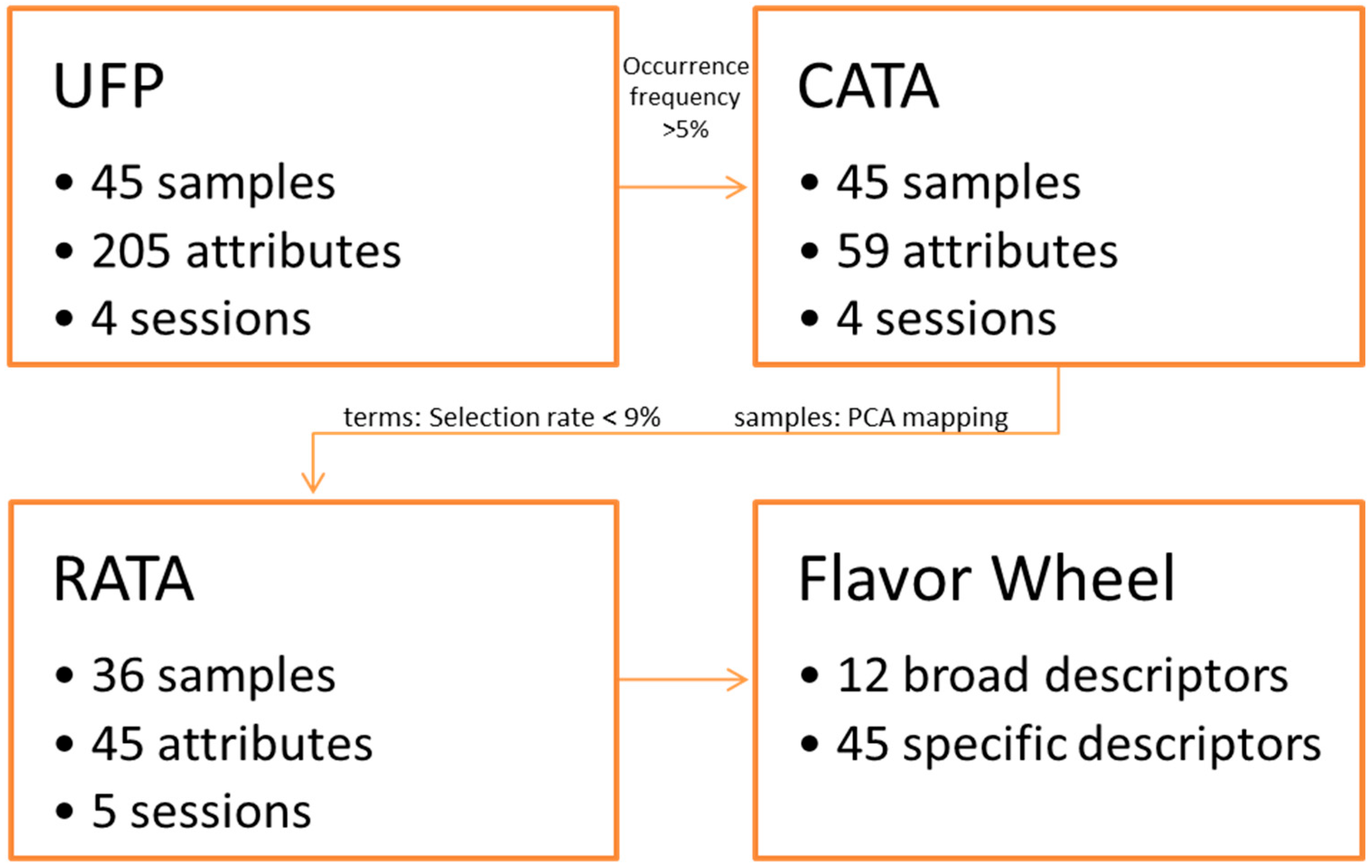
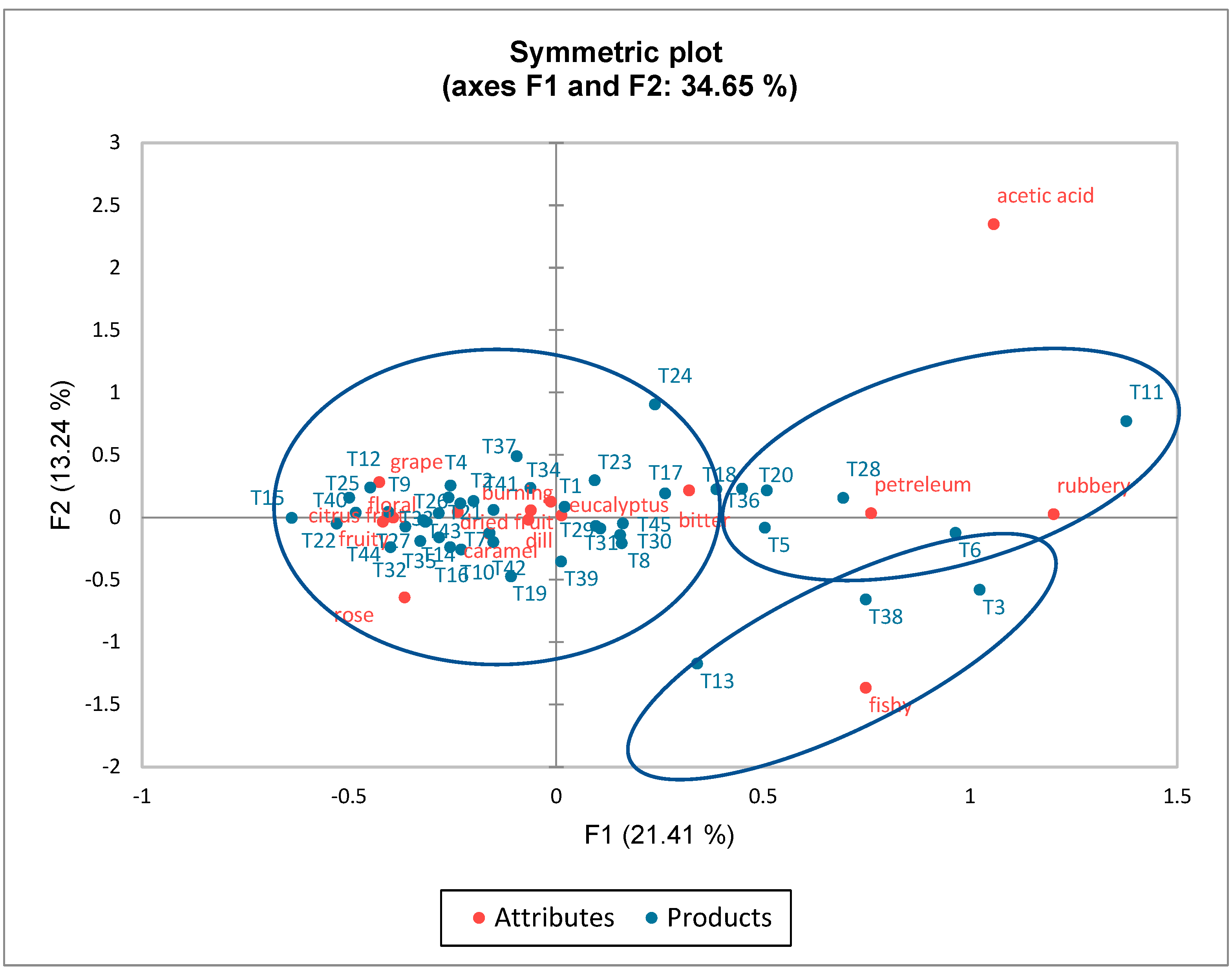
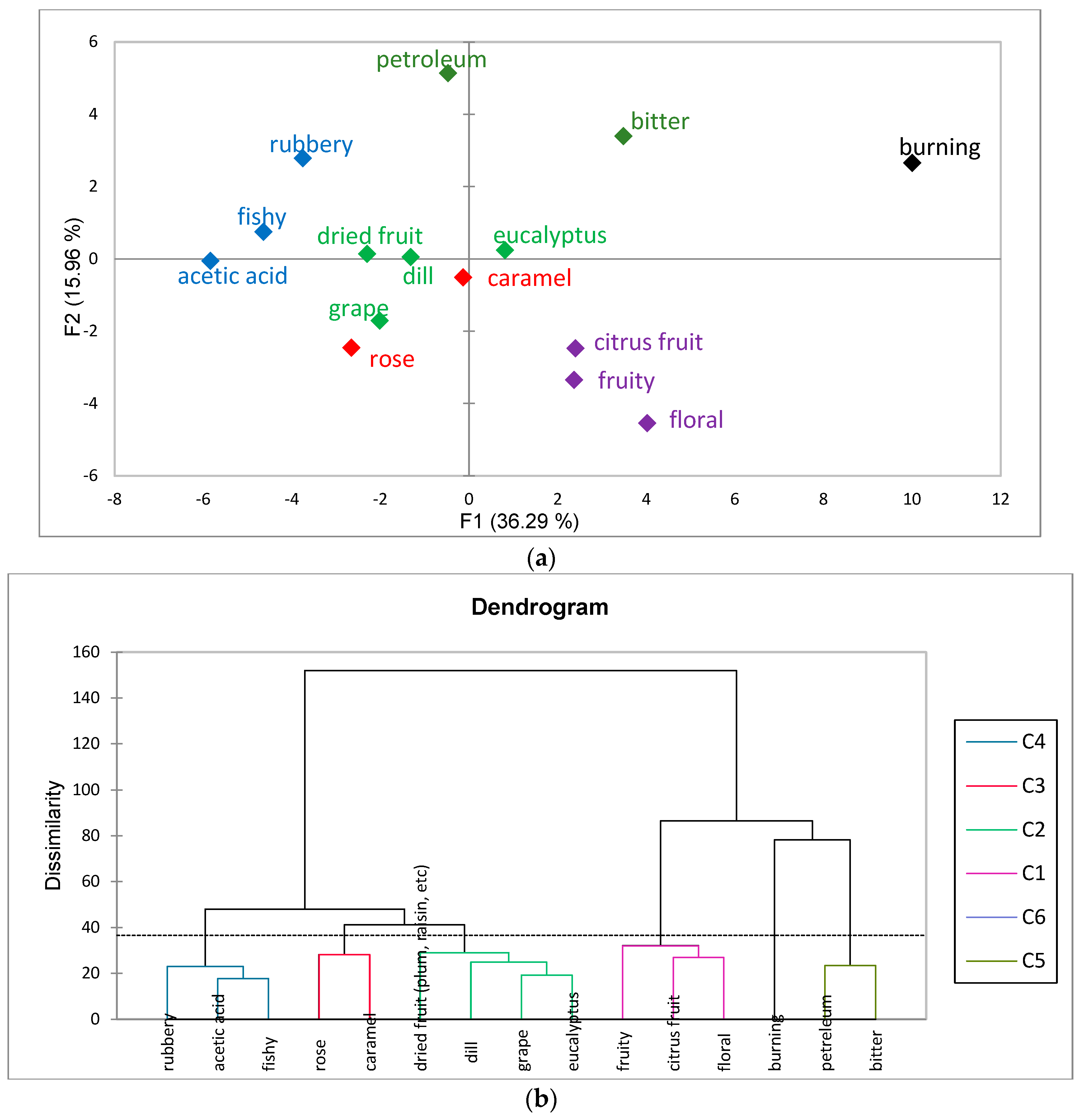
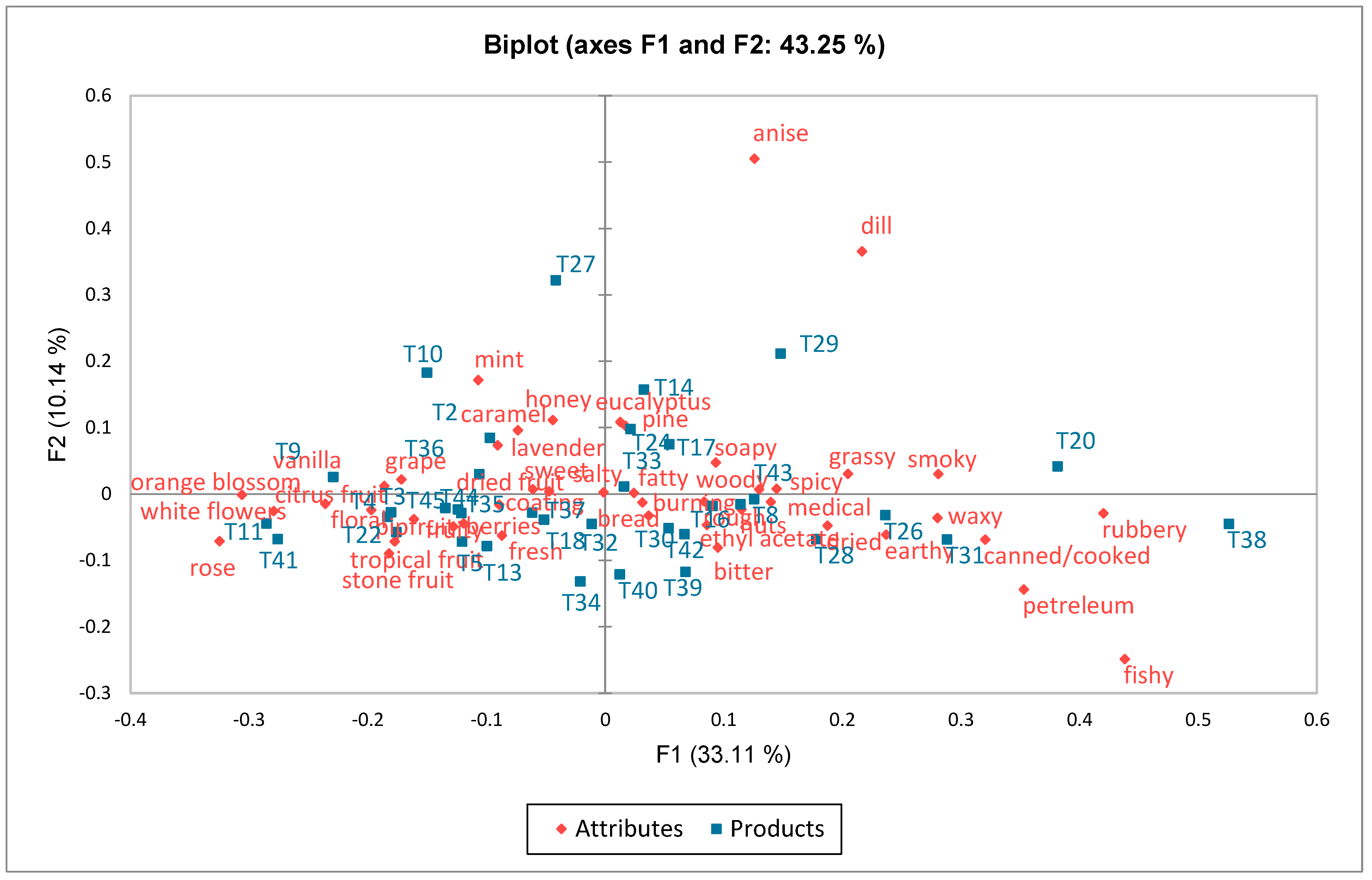
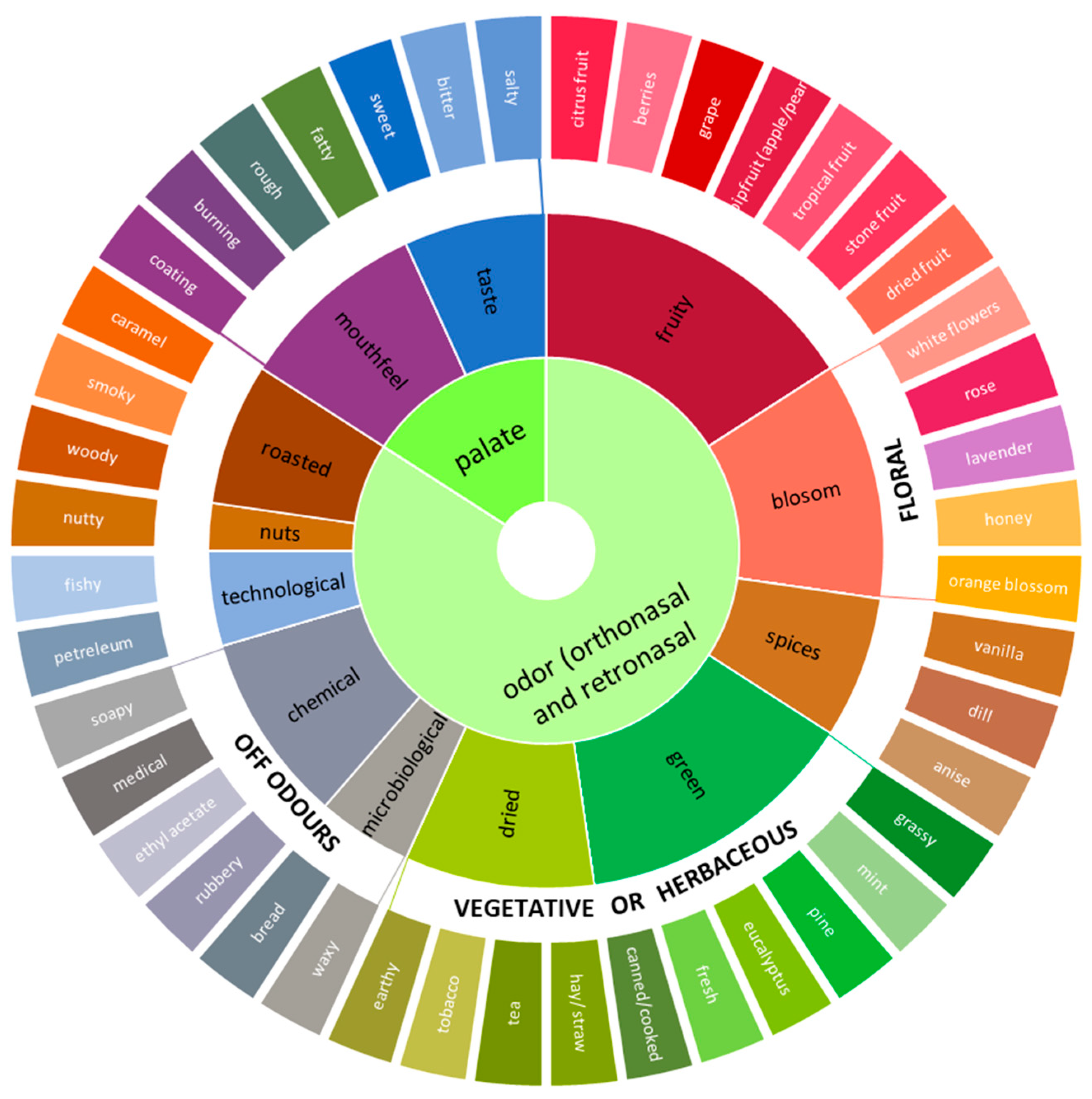
| Region | Code | UFP | CATA | RATA | |
|---|---|---|---|---|---|
| Greece | Tyrnavos | Τ1 | ✓ | ✓ | |
| Τ2 | ✓ | ✓ | ✓ | ||
| Τ3 | ✓ | ✓ | ✓ | ||
| Τ4 | ✓ | ✓ | ✓ | ||
| Τ5 | ✓ | ✓ | ✓ | ||
| Τ6 | ✓ | ✓ | |||
| Τ27 | ✓ | ✓ | ✓ | ||
| Τ28 | ✓ | ✓ | ✓ | ||
| Τ29 | ✓ | ✓ | ✓ | ||
| Τ30 | ✓ | ✓ | ✓ | ||
| Τ31 | ✓ | ✓ | ✓ | ||
| Τ32 | ✓ | ✓ | ✓ | ||
| Thessaly | Τ7 | ✓ | ✓ | ||
| Τ8 | ✓ | ✓ | ✓ | ||
| Τ9 | ✓ | ✓ | ✓ | ||
| Τ10 | ✓ | ✓ | ✓ | ||
| Τ11 | ✓ | ✓ | ✓ | ||
| Peloponnese | Τ12 | ✓ | ✓ | ||
| Τ13 | ✓ | ✓ | ✓ | ||
| Τ15 | ✓ | ✓ | |||
| Τ16 | ✓ | ✓ | ✓ | ||
| Τ17 | ✓ | ✓ | ✓ | ||
| Thrace | Τ18 | ✓ | ✓ | ✓ | |
| Τ19 | ✓ | ✓ | |||
| Central Greece | Τ14 | ✓ | ✓ | ✓ | |
| Τ22 | ✓ | ✓ | ✓ | ||
| Τ20 | ✓ | ✓ | ✓ | ||
| Τ21 | ✓ | ✓ | |||
| Τ35 | ✓ | ✓ | ✓ | ||
| Τ36 | ✓ | ✓ | ✓ | ||
| Crete | Τ23 | ✓ | ✓ | ||
| Τ24 | ✓ | ✓ | ✓ | ||
| Τ25 | ✓ | ✓ | |||
| Τ33 | ✓ | ✓ | ✓ | ||
| Τ34 | ✓ | ✓ | ✓ | ||
| Cyclades | Τ26 | ✓ | ✓ | ✓ | |
| Italy | Τ37 | ✓ | ✓ | ✓ | |
| Τ38 | ✓ | ✓ | ✓ | ||
| Cyprus | Τ39 | ✓ | ✓ | ✓ | |
| Τ40 | ✓ | ✓ | ✓ | ||
| Τ41 | ✓ | ✓ | ✓ | ||
| Τ42 | ✓ | ✓ | ✓ | ||
| Τ43 | ✓ | ✓ | ✓ | ||
| Τ44 | ✓ | ✓ | ✓ | ||
| Τ45 | ✓ | ✓ | ✓ | ||
| Attribute | p-Value | Attribute | p-Value | Attribute | p-Value | Attribute | p-Value |
|---|---|---|---|---|---|---|---|
| anise | <0.0001 | ethyl acetate | 0.013 | mint | 0.099 | smoky | 0.006 |
| berries | 0.405 | eucalyptus | 0.442 | nuts | 0.253 | soapy | 0.543 |
| bitter | 0.121 | fatty | 0.634 | orange blossom | 0.0001 | spicy | 0.006 |
| bread | 0.270 | fishy | 0.006 | petroleum | <0.0001 | stone fruit | 0.006 |
| burning | <0.0001 | floral | 0.0003 | pine | 0.327 | sweet | 0.673 |
| canned/cooked | 0.022 | fresh | 0.112 | pip fruit (apple/pear) | 0.071 | tropical fruit | 0.197 |
| caramel | 0.377 | fruity | 0.011 | rose | 0.019 | vanilla | 0.002 |
| citrus fruit | 0.001 | grape | 0.008 | rough | 0.001 | waxy | 0.0004 |
| coating | 0.001 | grassy | 0.003 | rubbery | 0.001 | white flowers | 0.007 |
| dill | 0.017 | honey | 0.648 | salty | 0.819 | woody | 0.297 |
| dried (hay, straw, tea) | 0.009 | lavender | 0.291 | ||||
| dried fruit | 0.490 | medical | 0.161 | ||||
| earthy | 0.083 |
| Sensory Modality | Descriptions | Occurrence (%) | Sensory Modality | Descriptions | Occurrence (%) |
|---|---|---|---|---|---|
| Odor (ortho and retronasal) | Citrus fruit | 88.89 | Odor (ortho and retronasal) | Mint | 60 |
| Floral | 88.89 | Medical | 55.56 | ||
| Eucalyptus | 86.67 | Earthy | 55.56 | ||
| Grassy | 84.44 | Pine | 53.33 | ||
| Anise | 84.44 | Dill | 53.33 | ||
| Fresh | 82.22 | Smoky | 53.33 | ||
| Dried (hay, straw, tea) | 82.22 | Grape | 51.11 | ||
| Ethyl acetate | 82.22 | Waxy | 51.11 | ||
| Stone fruit | 77.78 | Nuts | 51.11 | ||
| Fruity | 75.56 | Berries | 46.67 | ||
| Canned/cooked | 75.56 | Rose | 44.44 | ||
| Tropical fruit | 73.33 | Lavender | 44.44 | ||
| Vanilla | 73.33 | Rubbery | 44.44 | ||
| Honey | 73.33 | Fishy | 33.33 | ||
| White flowers | 71.11 | Mouthfeel | Burning | 93.33 | |
| Orange blossom | 68.89 | Coating | 91.11 | ||
| Soapy | 68.89 | Fatty | 75.56 | ||
| Petroleum | 68.89 | Rough | 64.44 | ||
| Woody | 68.89 | Dry | 44.44 | ||
| Bread | 66.67 | Sweet | 97.78 | ||
| Caramel | 66.67 | Basic tastes | Bitter | 95.56 | |
| Pip fruit (apple/pear) | 64.44 | Salty | 64.44 | ||
| Spicy | 62.22 | ||||
| Dried fruit (plum, raisin, etc.) | 60 |
Disclaimer/Publisher’s Note: The statements, opinions and data contained in all publications are solely those of the individual author(s) and contributor(s) and not of MDPI and/or the editor(s). MDPI and/or the editor(s) disclaim responsibility for any injury to people or property resulting from any ideas, methods, instructions or products referred to in the content. |
© 2025 by the authors. Licensee MDPI, Basel, Switzerland. This article is an open access article distributed under the terms and conditions of the Creative Commons Attribution (CC BY) license (https://creativecommons.org/licenses/by/4.0/).
Share and Cite
Tsapou, E.A.; Ignatiou, P.; Zampoura, M.; Koussissi, E. Construction of Sensory Wheel for Grape Marc Spirits by Integration of UFP, CATA, and RATA Methods. Beverages 2025, 11, 101. https://doi.org/10.3390/beverages11040101
Tsapou EA, Ignatiou P, Zampoura M, Koussissi E. Construction of Sensory Wheel for Grape Marc Spirits by Integration of UFP, CATA, and RATA Methods. Beverages. 2025; 11(4):101. https://doi.org/10.3390/beverages11040101
Chicago/Turabian StyleTsapou, Evangelia Anastasia, Panagiotis Ignatiou, Michaela Zampoura, and Elisabeth Koussissi. 2025. "Construction of Sensory Wheel for Grape Marc Spirits by Integration of UFP, CATA, and RATA Methods" Beverages 11, no. 4: 101. https://doi.org/10.3390/beverages11040101
APA StyleTsapou, E. A., Ignatiou, P., Zampoura, M., & Koussissi, E. (2025). Construction of Sensory Wheel for Grape Marc Spirits by Integration of UFP, CATA, and RATA Methods. Beverages, 11(4), 101. https://doi.org/10.3390/beverages11040101






